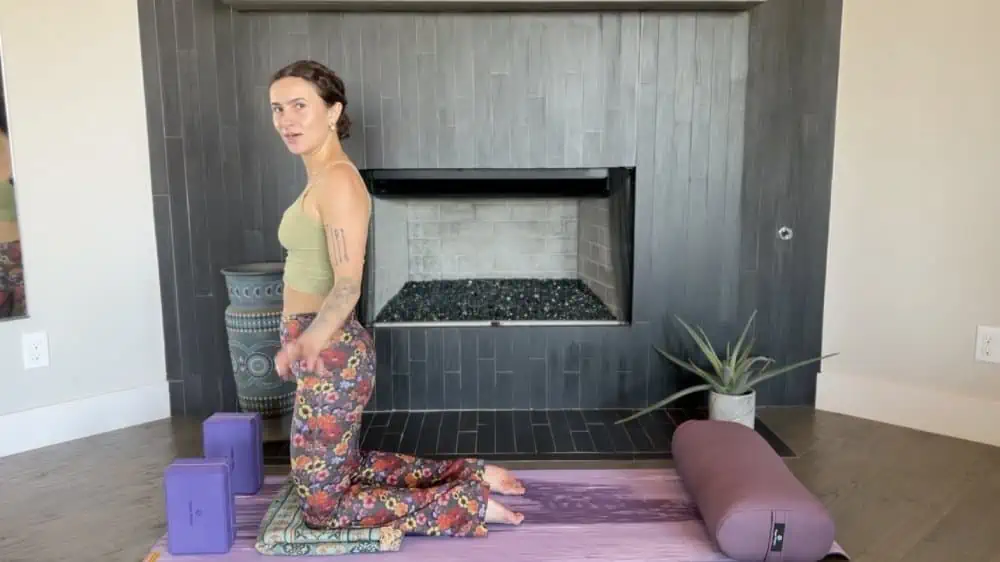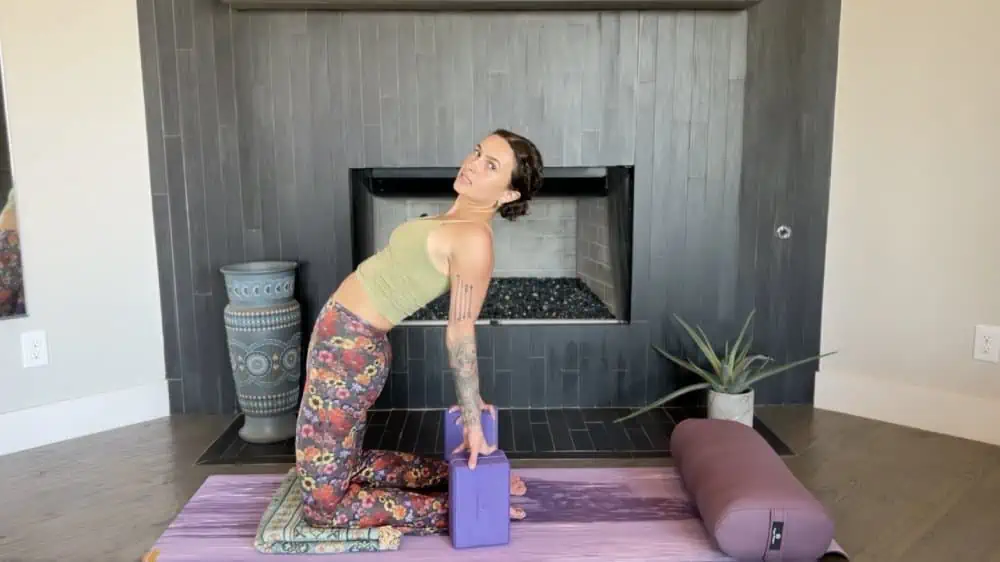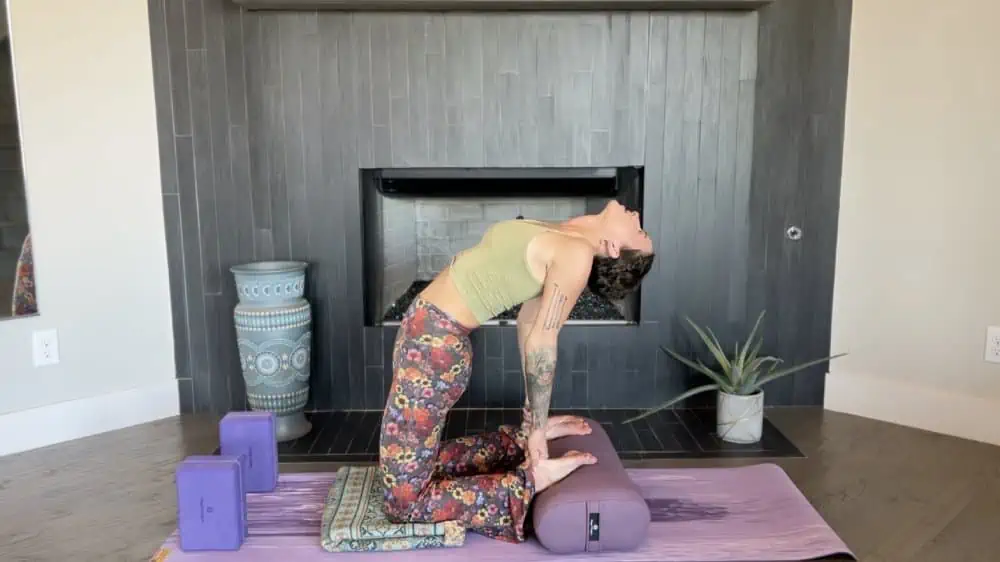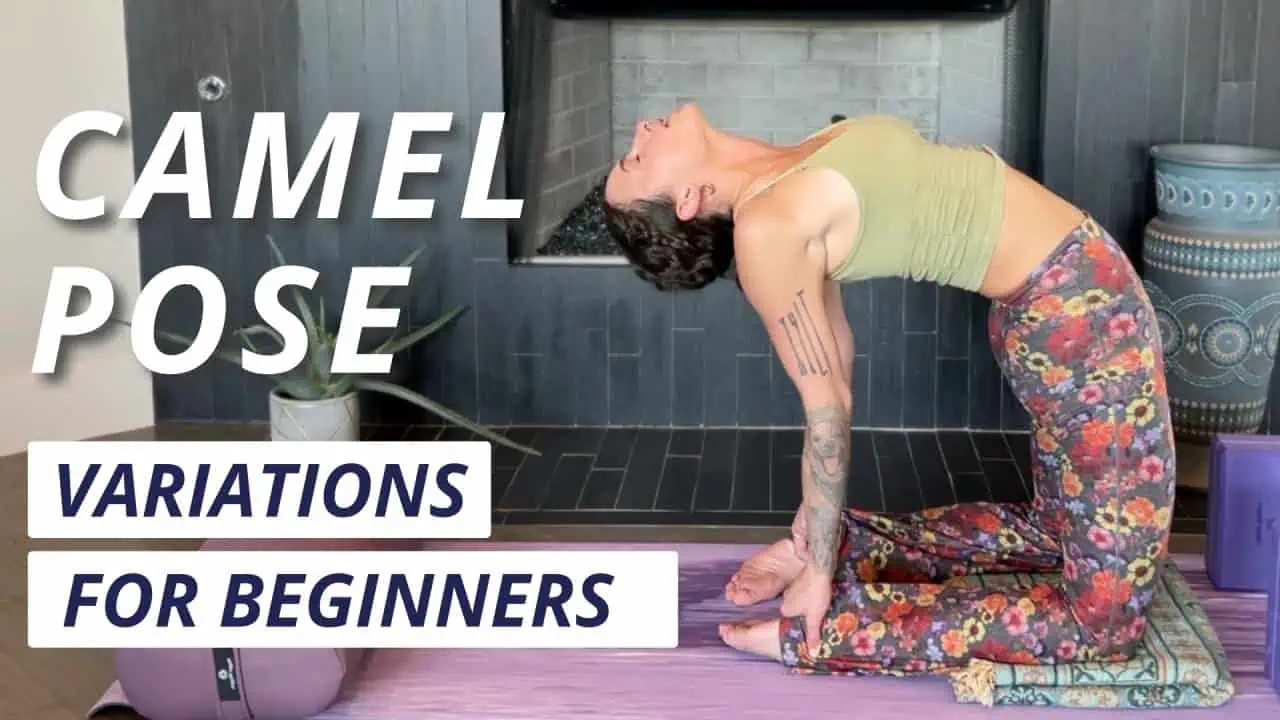Camel Pose (Ustrasana) enhances spinal flexibility, improves posture, and opens the heart, offering both physical and emotional benefits for those seeking to counteract the effects of a sedentary lifestyle.
| CAMEL POSE | |
|---|---|
| Alternate name: | Ustrasana |
| Difficulty level: | Intermediate |
| Pose category: | Backbend |
| Muscle groups: | Rectus abdominis (abdomen) External obliques (abdomen) Hip flexors (hips) Quadriceps (thighs) Pectoralis major (chest) Anterior deltoids (shoulders) Erector spinae (back) Serratus anterior (ribs/underarm) Trapezius (upper back) Latissimus dorsi (mid-back) Triceps brachii (arms) |
| Physical benefits: | Increases spinal flexibility and improves posture. |
| Therapeutic applications: | Back pain, Posture improvement |
| Preparatory poses: | Sun Salutations (Surya Namaskar) Sphinx Pose (Salamba Bhujangasana) Cobra Pose (Bhujangasana) |
| Counterposes that follow well: | Rabbit Pose (Shashankasana) Child's Pose (Balasana) Seated Forward Fold (Paschimottanasana) |
| Chakras activated: | Heart Chakra (Anahata Chakra) |
| Most helpful prop: |  Yoga blocks next to feet - Provides extra lift, easier reach. See latest price |
Craving relief from slouching over your computer? Camel Pose (Ustrasana) is an intermediate backbend posture that offers deep stretch through the entire front body as well as the neck and back. As your hips, thighs, abdomen, and chest open, your spine forms a beautiful arch that can help prepare for more advanced backbends.
Camel Pose is popular in Ashtanga and Vinyasa yoga flows, and is also one of the 26 Bikram Yoga postures. But many of us find ourselves dreading the pose because of discomfort or lightheadedness.
Here is everything you need to know about getting into Camel Pose with less struggle and more relief.
Contents
Why is Camel Pose so difficult?
Camel Pose is an intermediate-to-challenging posture because it requires full-body engagement and significant flexibility in your spine. To make Camel Pose more accessible, you can keep your hands on your lower back or place yoga blocks next to your feet to get a little extra lift from the ground.
What is the Camel Pose Good For? (Pose Benefits)
Camel Pose is a powerful asana that can improve your posture, increase spinal mobility, stretch open your hips, open your heart, and promote emotional release. The name Ustrasana (ooh-STRAHS-uh-nuh) comes from the Sanskrit words “ustra” (camel) and “asana” (pose or posture) because the pose resembles a camel’s hump.
Camel has shown to help:
- Increase spinal flexibility: Spinal mobility isn’t just for pretty backends; it can dramatically reduce back pain! Ustrasana flexes your spine backward to promote a greater range of motion in your back. Camel Pose not only improves spinal flexibility, but it also strengthens the back muscles supporting your vertebral column.
- Improve posture: “Tech neck” is the slouched, hunchback posture that most modern humans have adopted as a result of sedentary lifestyles and too much time on devices. Research shows that yoga backbends can dramatically improve posture and lengthen the space between vertebrae. Camel Pose, in particular, lengthens and strengthens the neck and back muscles.
- Improve digestion: Camel Pose stimulates the kidneys to (in your lower back region) to improve detoxification and digestion. While you should never practice yoga on a full stomach, Camel Pose is an excellent de-bloating posture for an hour or so after a meal.
- Hip opening: As your hips press forward in Camel Pose, they are simultaneously lengthened and strengthened. This is one of the best hip-opening asanas for supporting your hip flexors.
- Heart opening: As you open your chest to the sky, Ustrasana directly links to your heart center. The heart chakra is heavily activated in this posture, which can help improve your sense of compassion, self-love, and care for others. The slightly inverted nature of the pose can also improve your blood flow and cardiovascular system.
Prefer video? Here’s a complete tutorial on how to perform the Camel Pose, plus easier variations for beginners:
Why is Camel Pose emotional?
Traditional yoga philosophy asserts that many of our traumas and emotions are stored in our hips. Modern scientists have explored a similar concept and created bodily maps of emotions that explain how specific memories and feelings are physically expressed in different parts of the body.
If a few spontaneous tears (not painful ones!) come to your eyes during Camel Pose, this might be why! This posture offers a range of mental benefits, including stress relief, better sleep, and increased mental clarity.
Step-by-Step Instructions
Getting into Camel Pose requires special attention to lifting, lengthening, and strengthening before you arch backward. In order to prevent any low back injury, set a strong foundation before you backbend.
- Start from a kneeling position at the front of your mat, with cushioning beneath your knees if desired. Check that your knees are hip-width apart and the tops of your feet are lightly pressing into the mat. Lengthen the spine tall and slightly tuck your tailbone under you to keep your back body as straight as possible.
- Bring your hands to your lower back as if you are placing your hands in your back pockets. Your palms should lightly press against your sacrum (the bone at the base of your spine) to support your lower back.
- Inhale and lift your gaze upward. Imagine lifting your torso up and away from your hips. Slowly begin to lean backward and expand openly across your chest. Lift your chin and gaze as high as it feels comfortable for your neck.
- Exhale and flex your glutes to push your hips forward. Keep the front thighs, quads, and abs fully engaged to support the back as you bend. The front of the body should feel like it is stretching open. Keep looking up and back.
- On an inhale, slowly lower your hands to your heels. When you’ve stabilized, pull slightly upward on your heels to use them as leverage to shift the weight forward. Strongly engage your quads and glutes as the hips move toward the front of the mat. With your spine in a full backbend, imagine your shoulder blades kissing together beneath you.
- Breathe and let your head arch backward in a comfortable way. Don’t kink your neck. Inhale and exhale slowly, keeping your gaze up and slightly behind you. If you feel a little lightheaded, this is normal. However, you should slowly release from the pose if you begin to feel faint.
- Hold Camel Pose for 3 to 5 full breaths.
- To exit, bring your hands one by one back to the sacrum as if they were returning to your back pockets. Support the lower back as you engage your core and gently rise from the backbend.
- If desired, rest in Child’s Pose to allow your spine to rest in the opposite direction. Allow your body to recover for as long as needed.
Tips for Mastering the Pose
Camel Pose is difficult even for people who have been practicing yoga for years. If you want to master this asana, focus on your alignment and engagement with these tips:
Tip #1: Use a folded blanket, extra-thick mat, or yoga knee pads

There is already enough to focus on during Camel Pose, so you shouldn’t have to worry about your knees! Your knees and shins must be comfortable as you press them into the floor. If a standard yoga mat leaves your knee bones screaming, add some extra cushion before advancing.
Tip #2: Use your heels or block as leverage to lift

Once your arms are lowered behind you, allow your hands to find your heels or a block that you can use as leverage. Pushing into the heels or block can help you lift the chest and lift the spine so it doesn’t feel like you are crunching. This backbend is all about the upward opening of the heart.
Tip #3: Tuck your toes
If Camel Pose feels too difficult with the tops of your feet on the mat, try to tuck your toes underneath the heels. This adds a little more height to your feet so you can more easily reach your heels and keep your chest lifted.
Common Mistakes
Camel Pose has a lot going on, so it’s important to do a full-body scan to ensure you are in alignment. Avoid injury and get the most out of this pose by refraining from these common pitfalls.
Common Mistake #1: Hips and thighs falling back
If your hips and thighs are moving back with you, the spine doesn’t actually get a chance to arch into the signature “camel’s hump.” Instead, sunken thighs cause your chest to sink and knock your body out of alignment.
How to Fix It: Keep your thighs perpendicular to the floor (making a 90° angle with your calves) by engaging your glutes and actively pressing your hips forward. Keep your hips above the knees at all times.
You can also practice Camel Pose by facing a wall. Keep your knees and thighs glued to the wall as you arch backward.
Common Mistake #2: Creasing or over-arching neck
A lot of people think they have to dramatically arch their necks backward to get into this backbend. However, kinking up the neck can be very uncomfortable and could even lead to a neck injury.
How to Fix It: Lead with your eyes and focus on opening the torso rather than dangling the neck backward. If it feels comfortable, keep your neck muscles slightly engaged at the point where your nose faces straight up to the ceiling. You can keep your chin tucked slightly to prevent crunching into those neck vertebrates.
Common Mistake #3: Not lifting upward
If you don’t have your lower body engaged, your upper back may feel like it’s slouching back into Camel rather than elegantly arching. This pose is not meant to feel loose or easy.
How to Fix It: Camel Pose is more about pressing forward than it is about falling back. Your rib cage should feel like it’s expanding and lifting from your hips. Once your hands have reached your heels, the most important thing to remember is to lift and press. Tuck your tailbone, engage the glutes, and keep those hips reaching toward the front of the mat as your chest expands. The hips, thighs, and knees should be in one line.
Variations and Modifications

If you aren’t quite ready for the full expression of Ustrasana, these modifications can help you work toward the full pose as you build your spinal flexibility and core strength.
Camel Pose Against a Wall
The easiest way to find your proper leg position in Camel Pose is to move into the posture while facing a wall. When you start in your kneeling position, make your knees and thighs touch the wall before you engage the glutes and start arching back. Check that your knees remain hip-width apart and your inner thighs stay active throughout the posture.
Camel Pose with Blocks
If your heels feel too far away to reach, place lengthwise blocks on the insides or outsides of the ankle bones. When you reach backward, grasp the blocks and press into them as you lift the chest up and press the hips forward.
Camel with a Chair

This beginner-friendly Ustrasana requires a yoga chair or any moderately low chair. Instead of forcing your body into an arch that you aren’t ready for, brace your hands on the chair and slowly ease into this backbend. Imagine your shoulder blades kissing behind you to open the chest.
Safety and Precautions
Before incorporating Ustrasana into your yoga practice, be sure that you don’t have any of these health issues:
- Knee injury
- Neck or spinal injury
- Joint problems or arthritis
- High or low blood pressure
Teaching the Pose
Before teaching Ustrasana to students, make sure you emphasize these cues to prevent anyone from injuring their lower back:
- Imagine tucking your hands in your back pockets and keep them there to support your lumbar spine.
- If you aren’t ready to arch backwards, hold in place at a height that feels comfortable to you.
- Breathe very slowly as you enter and exit the pose.
- Keep your glutes, quads, inner thighs, and back body fully flexed and engaged throughout the pose.
Preparatory Poses
Your spine and hip flexors should be thoroughly warmed up before attempting Ustrasana. Begin with:
- Sun Salutations (Surya Namasakar)
- Sphinx Pose (Salamba Bhujangasana)
- Cobra Pose (Bhujangasana)
- Lotus Pose (Salabhasana)
- Fish Pose (Matsyasana)
Counter Poses
Follow up Camel with these postures that rest the spine in the opposite direction:
- Rabbit Pose (Shashankasana)
- Child’s Pose (Balasana)
- Seated Forward Fold (Paschimottanasana)
Conclusion
Camel Pose (Ustrasana) is an elegant yet challenging posture to add to your yoga practice. Remember to remain engaged and lifted so that your low back is always supported.
Namaste!



